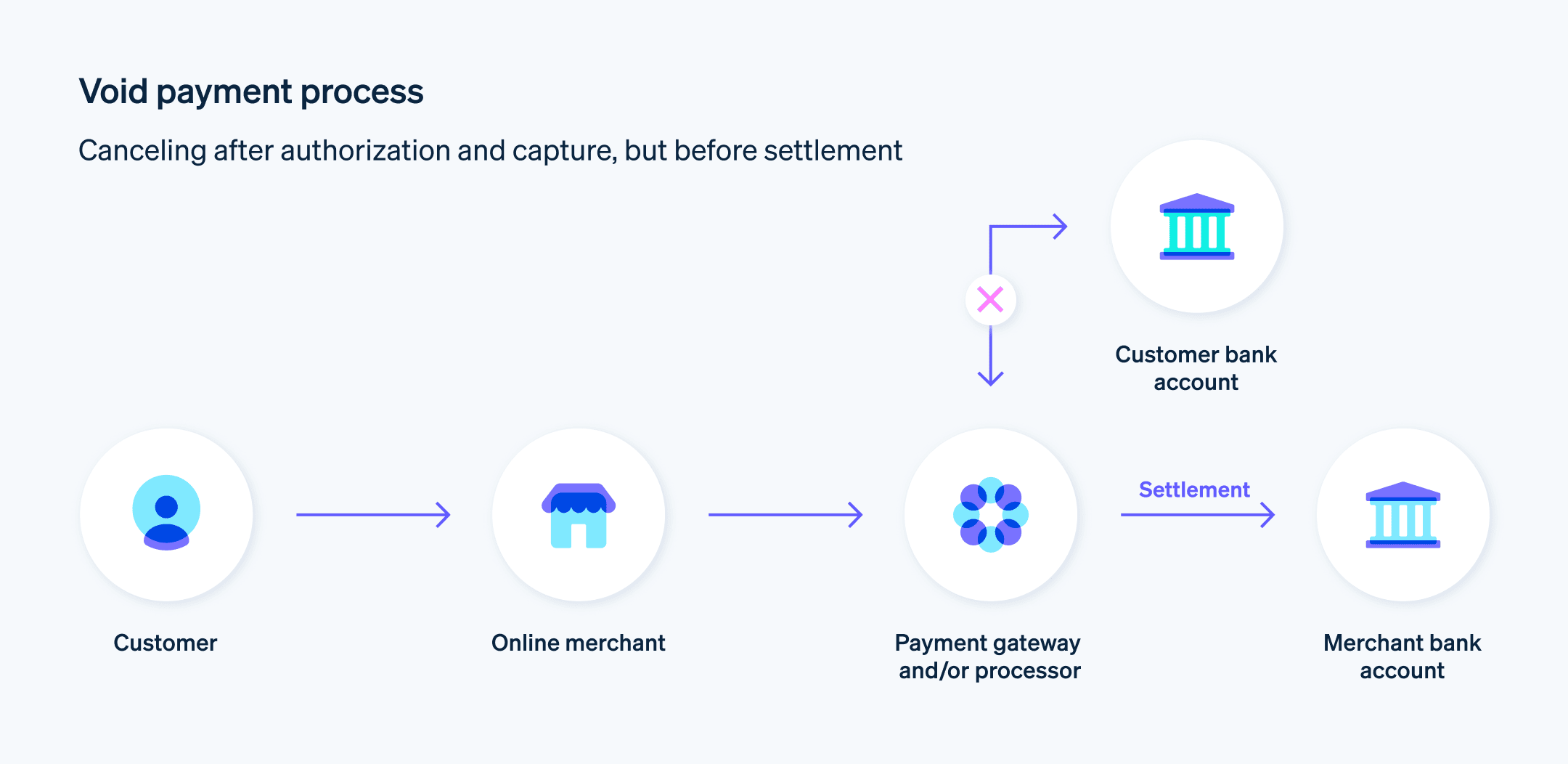在支付处理中,作废交易是在交易完成或结算之前取消交易。当交易被作废时,它会使该操作无效,并且不会向持卡人的账户收费。
下面,我们将介绍企业需要了解的作废交易的内容:它们为什么发生,如何影响会计操作,以及如何有效地处理它们。
目录
- 作废交易 vs. 退款
- 为什么会发生作废交易
- 作废交易如何影响会计
- 有效处理作废交易的技巧
- 作废交易的权利和保护
作废交易 vs. 退款
作废交易和退款都涉及撤销客户交易,但它们在时间、对客户账户的影响以及商家处理要求上有所不同。作废交易通常更简单且耗时较少,因为它们在交易未完成之前就阻止了交易;而退款则需要更多的处理时间和努力,影响客户的可用余额以及企业的收入和会计。
下面列出了作废交易和退款的主要区别。
作废交易
作废交易是在资金从客户账户转移到商家账户之前取消的信用卡或借记卡交易。
及时: 作废通常在交易发起后不久进行,通常会在同一天内完成。作废必须在交易批处理或结算之前进行,通常会在 24 小时内从客户的银行账单中消失。
客户账户: 当交易被作废时,客户的账户不会被收费。如果交易金额最初被作为待处理交易暂时冻结,该冻结将被解除。
商家处理: 对商家而言,作废交易意味着资金不会被接收,销售额也不会包括在待结算的交易批次中。
记录: 交易可能会在客户账户中显示为待处理状态,但会随后消失。商家通常会将作废交易与完成的销售分别记录。

退款
退款是在交易完成后撤销交易。从客户账户转移到商家账户的资金将被退还到客户账户。
及时: 退款可以在原交易后的几天、几周甚至几个月发生。该过程不是即时的,可能需要几个工作日才能反映在客户账户中。
客户账户: 一旦退款处理完成,客户的账户将收到与原交易金额相等的退款,从而撤销原始收费。
商家处理: 对商家而言,发起退款意味着将资金返还给客户账户。商家必须调整其会计记录,以反映资金的返还。
记录: 退款将作为来自商家的信用出现在客户的账单上。商家必须保留退款的详细记录,以便进行会计核对。
为什么会发生作废交易
作废交易发生在多种场景中,但主要出现在零售和服务行业,这些行业通常会立即处理支付。下面列出了常见的作废交易场景。
录入错误: 如果收银员或销售员输入了错误的金额或选择了错误的商品,必须作废交易,以确保客户不会被错误地收费。
重复交易: 有时,由于技术故障或人为错误,一笔交易可能会被处理多次。作废重复交易可以确保客户不会为同一笔购买支付多次费用。
客户决策: 客户可能会在交易后立即改变购买决定。商家可以作废交易以取消销售,并防止客户被收费。客户也可能改变他们的支付方式;如果交易尚未结算,可以作废原交易,使客户能够使用他们首选的支付方式支付。
技术问题: 销售点 (POS)系统故障或错误可能导致不正确的交易,需要作废。
欺诈预防: 如果商家怀疑某笔交易是欺诈交易,可能会作废交易,以防止财务损失并保护客户账户。
授权冻结: 在酒店业或汽车租赁等行业,通常会预授权交易以确保资金的可用性。如果最终交易金额不同或服务被取消,预授权费用可能会被作废。
产品不可用: 如果某个售出的商品结果显示缺货或无法提供,可能需要作废交易。
政策要求: 某些行业有特定的合规标准或商店政策,在特定情况下可能需要作废交易,例如如果年龄限制未满足,则需要作废限制年龄的销售交易。
作废交易如何影响会计
无效交易应通过以下方式包含在企业的会计中。作废交易应该以以下方式包含在企业的会计记录中。
交易记录: 作废交易应包括在会计系统中,以确保所有财务活动都能透明且准确地报告。
销售对账: 尽管作废交易不会产生收入,但在销售对账时仍应考虑作废交易,以确保销售数字与收到的款项相符。
库存管理: 在零售中,作废交易应记录在库存记录中,以反映作废销售的商品仍然有库存。
报税: 作废交易不会贡献于应税收入。这些交易必须与已完成的销售区分开,以确保税务报告的准确性。
财务报表: 必须记录作废交易,以避免销售或应收账款数字被夸大,确保财务报表准确反映企业的财务状况和表现。
审计追踪: 审计人员可能会检查作废交易记录,以确保这些交易是合法的,并未用于掩盖不当的财务操作。
现金流: 作废交易不影响现金流,因此不应包含在现金流计算中。
客户记录: 准确记录作废交易对于保持客户信任非常重要。
有效处理作废交易的技巧
了解您的系统: 熟悉您的销售点 (POS) 或支付处理系统的功能。
迅速行动: 在交易被批量处理之前迅速作废交易。这可以避免更复杂的退款过程。
与客户沟通: 清楚地与客户沟通作废过程,保持良好的客户关系。确保他们理解交易将被取消,并告知他们应在银行对账单上看到什么。考虑在作废交易后跟进客户,确认他们在自己的账户上看到更正。
培训员工: 定期培训员工,了解作废交易的正确流程——如何完成作废操作以及为何这很重要。
记录作废流程: 为作废交易制定清晰的文档流程,供员工参考,包括如何作废交易、如何记录作废交易以及如何内部报告作废交易。
保持记录: 保持所有作废交易的详细记录,包括谁进行了作废交易及其原因。这对于审计和解决争议非常有用。
设定内部控制: 实施检查和平衡制度,以防止作废功能被滥用。这可能包括对超过一定金额的作废交易要求经理批准。
与财务记录对账: 定期将作废交易与财务记录对账,以确保报告的准确性并尽早发现差异。
利用可用技术: 考虑使用可用的技术或软件功能,简化或自动化作废过程,提高速度和准确性,减少管理负担。
审查流程改进: 定期审查作废交易作为业务财务分析的一部分。识别模式或趋势有助于发现需要更多培训的地方,或标记出销售过程中可能出现的问题。
作废交易的权利与保护
作废交易的具体权利因交易类型(例如信用卡、借记卡、ACH)和您所在司法管辖区的法律而有所不同。以下是通常适用的权利,分为企业和消费者两方面。
企业的权利与保护
企业在以下情况下有权作废交易。
双方同意: 双方同意取消订单。
定价错误: 广告中的价格不正确。
缺货: 购买的商品无法提供。
涉嫌欺诈: 有迹象表明欺诈活动。
消费者的权利与保护
消费者在以下情况下有权要求作废交易。
未经授权或错误收费: 消费者有权对任何他们认为未经授权或错误的交易提出异议。如果在规定的时间范围内发起(对于信用卡,这通常是 60 天内),可以触发作废过程。
涉嫌或确认欺诈: 如美国的公平信用结算法案所规定,保护消费者免受欺诈信用卡收费。如果交易是欺诈性的,消费者有权要求其作废且不承担责任。
本文中的内容仅供一般信息和教育目的,不应被解释为法律或税务建议。Stripe 不保证或担保文章中信息的准确性、完整性、充分性或时效性。您应该寻求在您的司法管辖区获得执业许可的合格律师或会计师的建议,以就您的特定情况提供建议。